Reviews
Congolese Artist Bodys Isek Kingelez’s Most Ambitious Work Is an Intricate Dream City. Here’s How to Understand It
"Bodys Isek Kingelez: City Dreams" is on view at Museum of Modern Art.
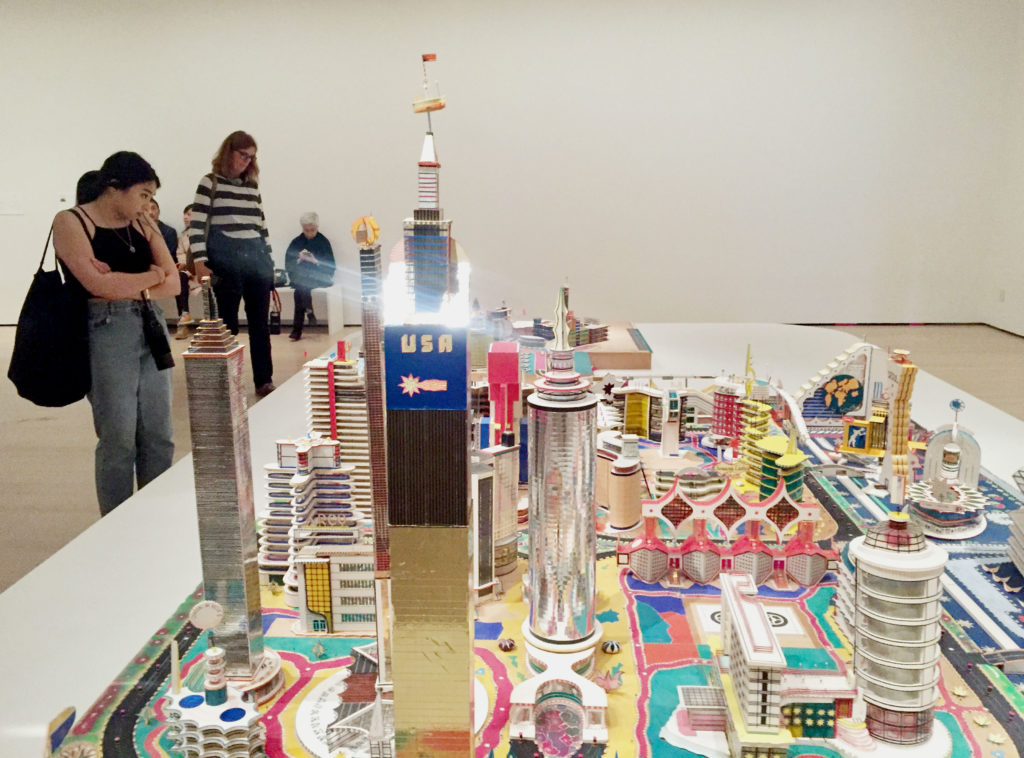
"Bodys Isek Kingelez: City Dreams" is on view at Museum of Modern Art.

Ben Davis

“City Dreams,” the lovely retrospective devoted to Congolese artist Bodys Isek Kingelez, is currently winning raves at the Museum of Modern Art. But the joys of Kingelez’s work are in the details, so I thought I might focus, here, on just one work: Ville Fantôme (1996), his model of a festive imagined city of shining office towers, colorful pavilions, orderly highways, parks, and rivers. Here it is:
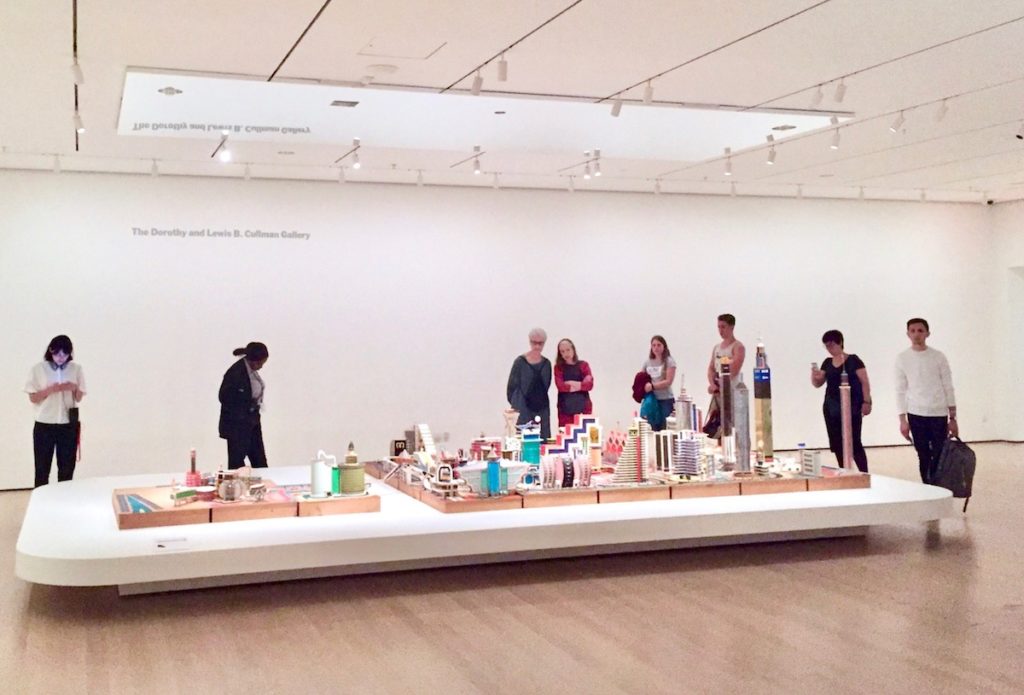
Ville Fantôme was the most ambitious work ever produced by the Kinshasa-based Kingelez (1948-2015), who described himself as “a designer, an architect, a sculptor, engineer, artist.” In the late ’80s, he gained widespread acclaim for his unique style of “extrêmes maquettes,” sculptural imaginings of buildings, at once meticulously conceived and fantastical, visions of a paradisiacal architecture he believed could heal the world. “I’m dreaming cities of peace,” he explained. “I’d like to help the Earth above all.”
The building below, one of many in Ville Fantôme’s dreamy cityscape, gives a sense of the pyrotechnics he could pack into one imagined building: a blue central tower attached to two wings that resemble, well, actual wings, inexplicably scalloped and inexplicably suspended in the air, a mix of modernist folly, space craft, and bat.

It’s such a wild and fully imagined bit of fantasy architecture that you almost miss the strangely indeterminate scale: the divisions of windows in the wings would seem to indicate that it was five stories, max; the grid in the main tower would suggest 16. It is actually not clear how the interior space would fit together, practically. Throughout Kingelez’s cities, consistent scale seems hard to pin down even as it all meshes together into a seamless fabric, giving the whole thing a subtly dream-like air.
Part of what makes Kingelez’s architecture so charming is the contrast between grandiose vision and handmade character. He worked with simple materials: cardboard, knife, glue, and whatever bits and pieces he could come up with for accents. The point, however, was generally not to highlight humble materials—the catalogue reminds us that, in the Congo, cardboard was actually “exotic, expensive, and imported.” Kingelez was always trying for a precious look.
In Ville Fantôme, even when the maquettes are accented with clearly found objects you get the feeling that Kingelez is using them because their forms simply worked with his preferred style of imaginary ornamentation. The repeated pushpin turrets and the scalloped medallion of the bottle cap crowning this tower are a case in point:
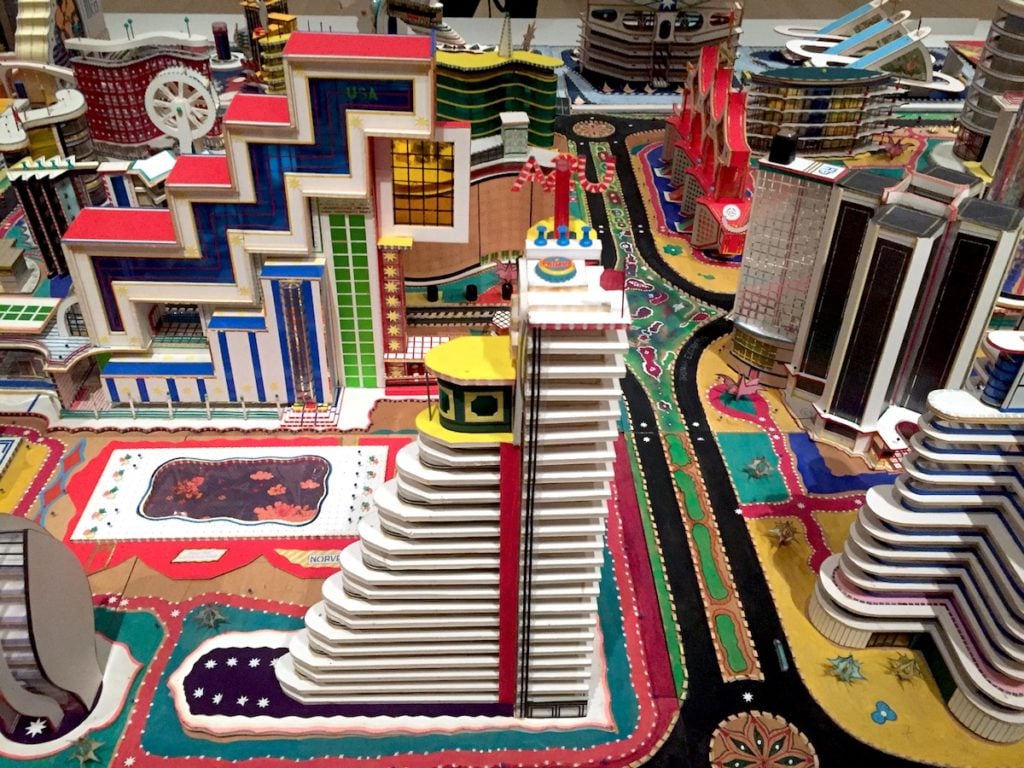
Ville Fantôme came at an important time in Kingelez’s career. His big break had come in 1989, when French curator André Magnin included several of his individual works in “Magiciens de la Terre,” a hotly debated, closely watched show at Paris’s Pompidou Center that attempted to open the Western museum world to a global perspective.
This international exposure gave Kingelez an expanded audience and validation of his vision. In its wake, he felt empowered to scale up his ambition, welding individual maquettes together into mini cities, peaking with this, his largest. Given this background, it is no coincidence that Ville Fantôme is a city pointedly international in orientation, an aerotropolis with an airport laid out on a separate island to one side.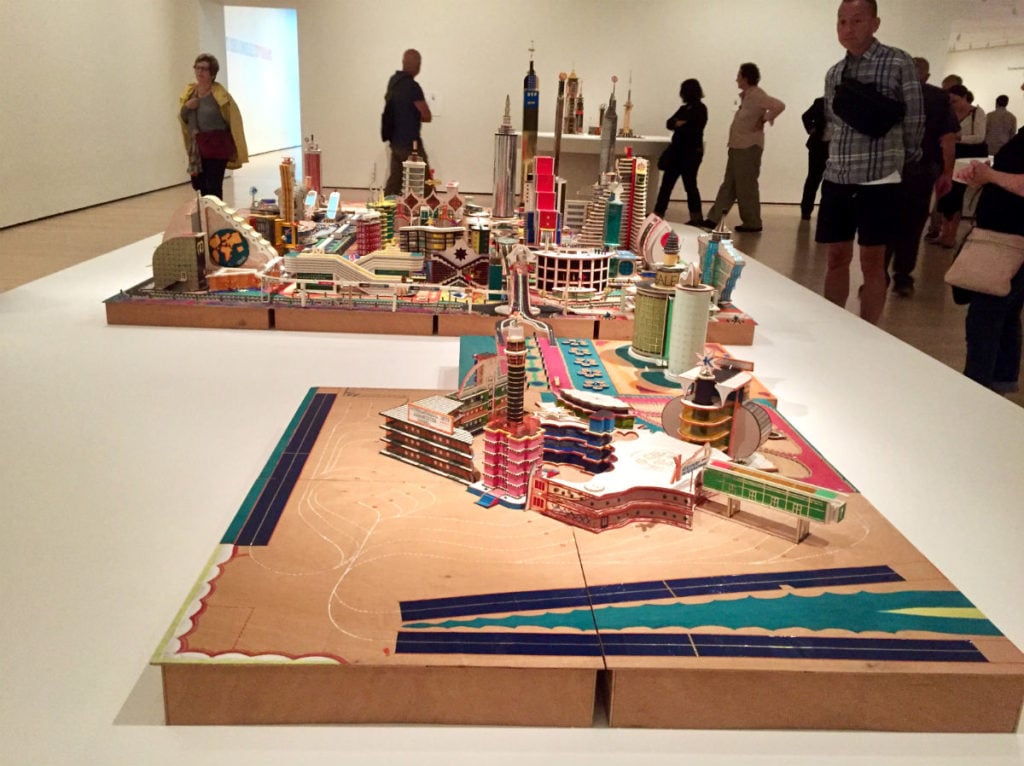
The city itself is something like a World’s Fair—or one of the international art biennials where Kingelez’s art became a staple in the ’90s—representing countries from all over. A train station declares itself “Vietnam Station;” a purple man-made lake is designated “Norvege” (Norway); a glittering office tower, sited next to the Town Council (“Conseil de Ville”), is claimed for “Canada”:

A hierarchy exists within this miniature utopia, roughly following the perceived hierarchy of the economic order in 1996. Multiple structures are labeled “USA”—including the city’s most imposing skyscraper:
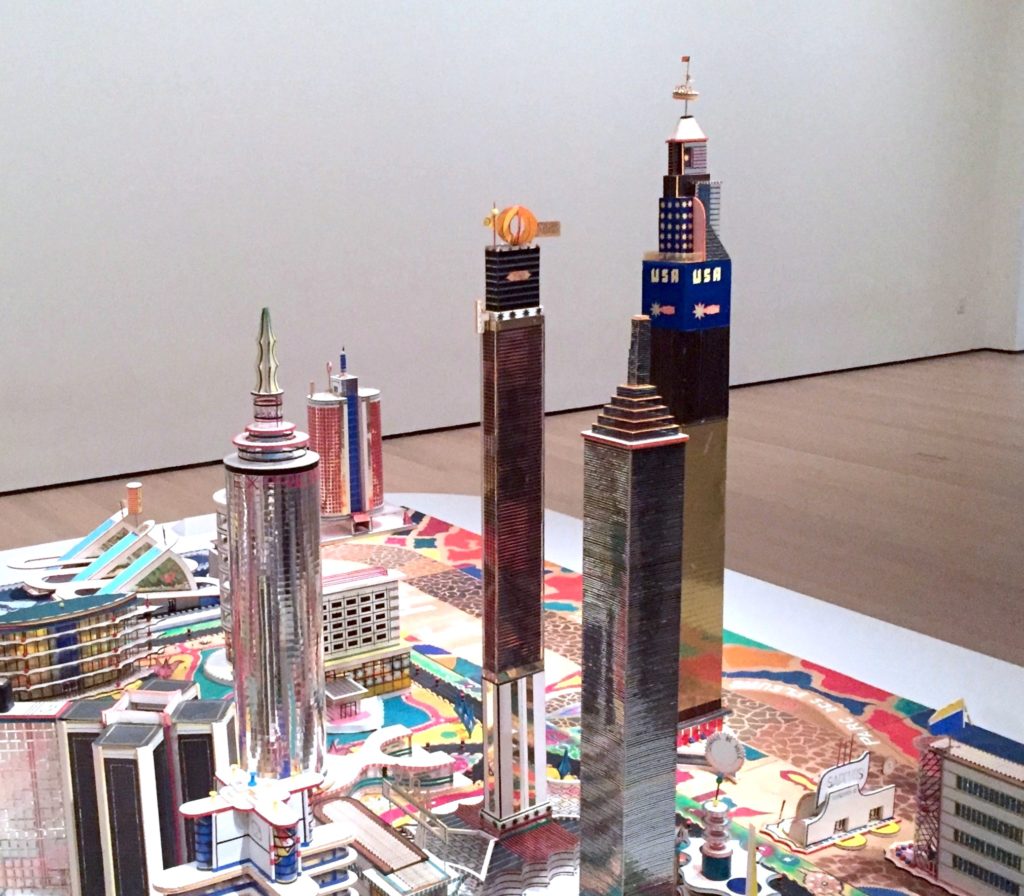
Kingelez appears to have had an interesting mental relationship to the United States. On one hand, he seems to have imagined it as the land whose taste for architectural spectacle matched his own—the ’80s and ’90s were peak vogue for architectural postmodernism, which resonates with the Congolese artist’s imaginary architecture, where ornament overwhelms function.
But Kingelez also had a truly remarkable belief in the world-historical status of his own vision, and seems also to have seen the US as a kind of personal rival. “He believed that the Americans had plundered all his ideas, all the great American architects had plundered all his ideas,” Magnin relates of one of his meeting with the artist in Kinshasa. “He told me a hundred times, ‘Bloody America, they stole all my ideas!’”
Perhaps this imagined rivalry explains an odd detail of the otherwise harmonious Ville Fantôme: atop the USA tower, there is an American flag—but it flies upside-down, as if Kingelez is declaring that he is both claiming and reversing its power.

On the other hand, the countries of Africa or, indeed, the Congo itself, are not given much prominence in Kingelez’s cosmopolitan vision. No doubt this reflected the reality of the artist’s actual position. “I am like a stranger in Congo, where I have never been recognized,” Kingelez lamented. “It’s mostly foreigners who commission my work.”
But the absence is striking here in that he had commenced his artistic career, in 1980, with a sculptural group, Kinshasa: Cité du 24 Novembre de l’Authenticité Africaine, paying homage to the post-colonial ambitions of his homeland and Congolese dictator Mobutu Sese Seko’s policy of “authenticité” (“authenticity”), meant to tear off the yoke of Western cultural imperialism.
Sixteen years after that work, the Mobutu regime’s grandiose building schemes and promises of renewal had definitively descended into kleptocracy. By 1996, the year Ville Fantôme was made, the country was mired in economic chaos and civil unrest; Mobutu would fall the following year. Kingelez’s vision, it seems, had turned both outwards and inwards.
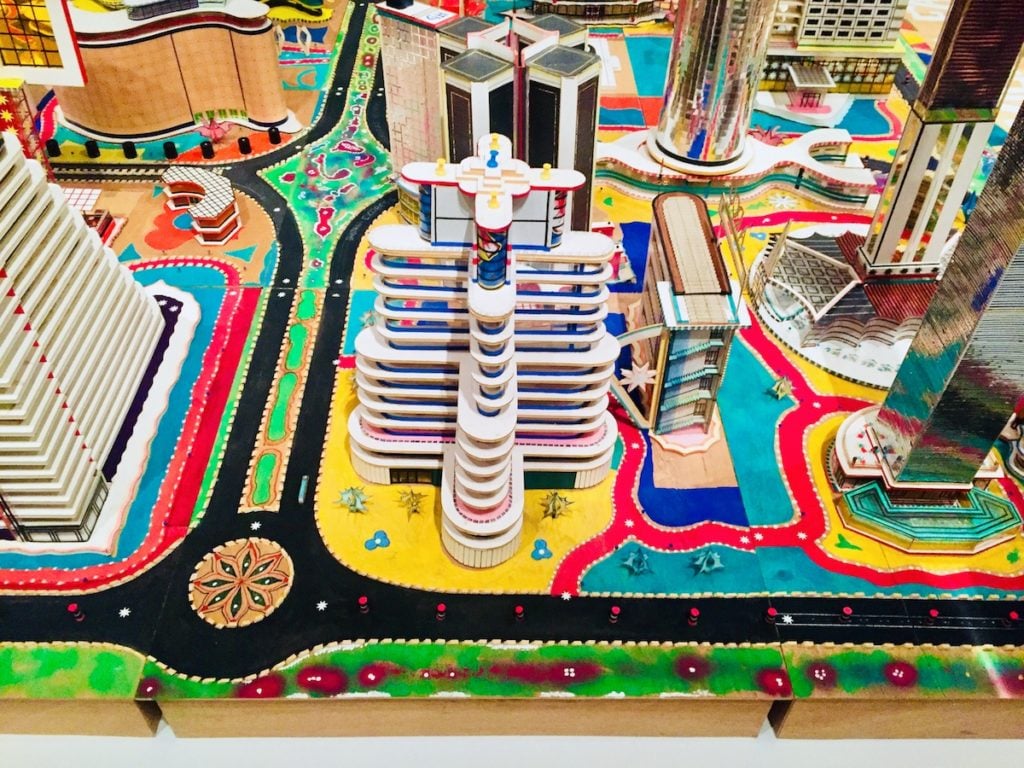
“There is no police force in this city, to protect the city, there are no soldiers to defend it, no doctors to heal the sick,” he explained of Ville Fantôme. “It’s a peaceful city where everybody is free. It’s a city that breathes nothing but joy, the beauty of life. It’s a melting pot of all the races in the world. Here you live in a paradise, just like heaven.”
It is, in other words, a world removed from any of the problems of his actual present. Indeed, there’s precious little evidence of any real people in his vision. Here as elsewhere, there aren’t even any private residences in Kingelez’s world, let alone slums. There are some cars on the highways—but very few. It all evokes a world of uncluttered freedom, but also a world that is too good for all but a chosen few. (Ville Fantôme, after all, means “Ghost Town.”)

The ground of this city oscillates between earnest markers of infrastructure (roads, rivers, medians, etc.) and festive patterns. It’s not always clear how they fit together or which is which. “[H]e imbued the works with the immediacy of thought—but they don’t have the perfection that thoughts have,” architect and Kingelez admirer David Adjaye writes in the catalogue. “Rather, they reflect distortions in the way the mind deals with images. Mental images are not precise: they are fleeting systems, with only sparks of thought.”
This is a city that would be at once a paradise and completely perplexing to live in. A glittering red and blue tower at one corner of the city is deposited in the middle of what appears to be a park and a lake, even as its neighboring trio of pavilions appear wreathed with inexplicable aerial roads:

This ambiguity of Ville Fantôme as a model city indifferent to the needs of any of its imagined inhabitants is mirrored by an ambiguity of this artwork as a sculpture in actual space: How are you supposed to view it?
Its jewel-box intricacies are fully realized on the level of individual model buildings, but the scale of the work as an ensemble means that you can’t get in to appreciate them. For whom are the details intended? (This dilemma is only partly solved by the MoMA installation device, conceived by artist Carsten Höller, of installing a mirror on the ceiling above it.)
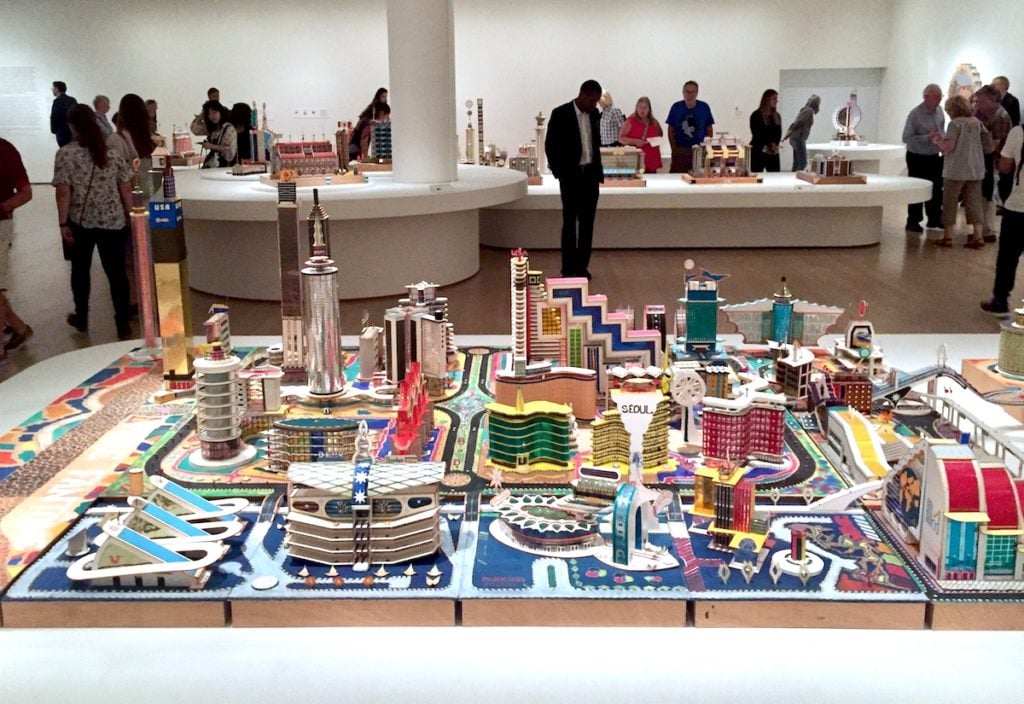
The answer is clear. Kingelez saw his vision as divinely inspired, and even called himself a “small god.” It is the impossible god’s-eye view of Kingelez that makes sense of the city.
As he did often throughout his work, the artist prominently inserted his own name into Ville Fantôme. In this case, the gesture is particularly striking, because “Bodys” is given more or less the same status, atop a building, as the names of any of the nation states that are saluted elsewhere in his city:

This is a vision that insists on being taken seriously as reality even as it refuses to conform to reality. Ego and infrastructure are one. That meshing is what makes a work like Ville Fantôme, and Kingelez’s work in general, feel so pleasantly optimistic. It also lends it, when you really look, a note of wistfulness—the kind of ache that you associate with waking up from a beautiful, impossible dream.
“Bodys Isek Kingelez: City Dreams” is on view at the Museum of Modern Art, through January 1, 2019.